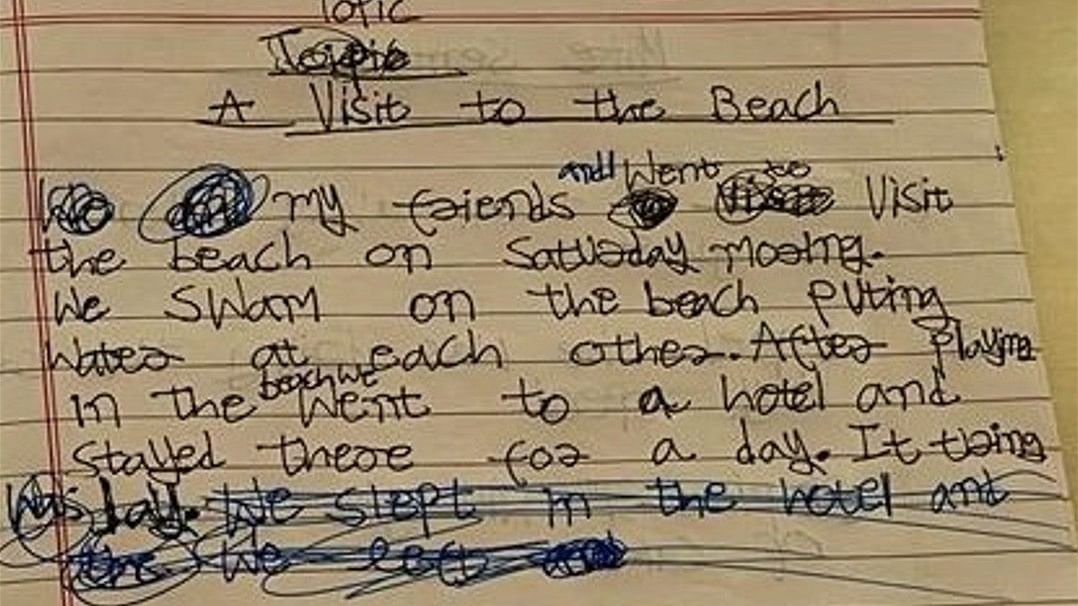
Handwriting may seem automatic, but complex behind-the-scenes coordination is needed for this. When a child has difficulty acquiring handwriting skills smoothly, it is important to recognize and get help, as there is no quick fix for handwriting. Dysgraphia is a neurological disorder that impairs writing ability and fine motor skills. The term neurological explains the connection between the brain areas of language, perception, motor coordination and automaticity.
Dysgraphia has a high rate of comorbidity with other learning disorders like reading and spelling disorders. It is an impairment of written expression that affects written communication. It presents symptoms at different ages, making diagnosis difficult and the condition often misunderstood. It stems from difficulties in fine motor coordination and visual perception, presenting poorly formed letters, slow, laborious writing and difficulty copying, drawing and writing spontaneously.
The DSM 5 (Diagnostic and Statistical Manual) includes dysgraphia under Learning Disorders. Learning disorders refer to the following symptoms being present for at least six months to be diagnosed:
Inaccurate or slow and effortful word reading
Difficulty understanding the meaning of what is read
Difficulty with spelling
Difficulty with written expression
Difficulties mastering number sense, number facts, or calculation
Difficulties with mathematical reasoning
Handwriting is an important milestone. Its development follows a progression from strokes to tracing, forming letters, spacing, building speed, etc. Handwriting challenges come in many forms. Poor pencil grip, slow pace of writing, untidy work, illegible writing, incomplete notes, and finally, a reluctance to engage in written work, leading to avoidance or even a build-up of anxiety, are among them.
The teacher and the parent should monitor the child’s handwriting, which is essential to academic growth and overall well-being. Impairment can affect the child’s ability to complete age-appropriate writing assignments.
Some of the warning signs or symptoms of dysgraphia are:
Preschool
Awkward grip or position when writing
Tires easily when writing
Avoidance of writing and writing tasks
Written letters are poorly formed, reversed or inconsistently spaced
Difficulty staying within margins
School-age
Illegible handwriting
Switching between cursive and print
Difficulty with word finding, sentence completion, written comprehension
Teenager and young adult
Difficulty organising written thought is a common issue. A trained professional can diagnose this through an educational assessment, analysing components like writing speed, legibility, spelling accuracy, copying skills, and other important factors like attention to task and mood.
Most hospitals have child psychologists who are trained and experienced to do the evaluation. Always go through a referral to access a good reputed professional. Once it is ascertained that the child needs help, the following accommodations are advised:
A supportive educational set-up that offers learning support through remedial sessions
Classroom accommodations like extra time and alternative ways of testing knowledge.
Technological accommodations like the use of a computer or laptop.
Modification of assignments into smaller manageable assignments.
The remedial programme conducted by a professional will consist of some of the following aspects:
Letter tracing
Developing motor imagery
Fine motor activities
Developing self-evaluation techniques
Feedback provision
A research by Berninger (2006) refers to handwriting as ‘learning by hand’, which tells us it is an integration of phonological codes (letter sounds and names), orthographic codes (letter forms) and graphomotor codes (written shapes), which tells us it is more than just motor skills. It is a brain-based skill that combines many processes to recall letter shapes and put them on paper automatically.
Studies have shown that handwriting contributes to fluency among budding writers. As in all interventions, both the child and family need support. Collaboration between the school, parents, and remedial teachers will improve the child's well-being.
Handwriting and emotions
Anxiety and stress can manifest as shaky handwriting, excess pen pressure or difficulties with processing thoughts and putting them down on paper. Pre-term babies, children with attention deficit or hyperactivity, children who experience trauma and those with chronic sickness may experience handwriting difficulties.
Writing anxiety is often seen in children due to pressure, expectations, environment and the task itself. It is important to meet a child psychologist to understand how to help the child in this situation, as it is manageable with intervention.
(The author is a cognitive psychologist and special educator based in Bengaluru)